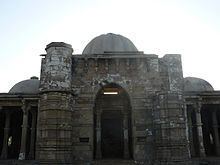Location India State Gujarat Ecclesiastical or organizational status Ruins Material Rubble masonry Number of minarets 1 | Affiliation Islam Year consecrated 15th century District Panchmahal district Municipality Champaner Architectural type Mosque | |
 | ||
Status Part of UNESCO Heritage Park Similar Kevada Masjid - Champaner, Nagina Masjid - Champaner, Jama Mosque - Champaner, Pavagadh Hill, Champaner‑Pavagadh Archaeological Park | ||
Lila Gumbaz Ki Masjid in Champaner, Gujarat state, western India is one of the 114 monuments listed by the Baroda Heritage Trust that are part of the Champaner-Pavagadh Archaeological Park, a UNESCO World Heritage Site. It is located near the east gate of the former city.
Contents
Architecture
The Masjid, built on a high plinth, has a frontage with an arched entrance at the centre flanked by two lateral arches. Initially, three entrances existed on the east, south, and north directions. There are well spaced minarets fashioned with horizontal cornices and mouldings, and decorated niches. Of the three domes, the central one has a fluted design and is colourful. On the north-east corner there is a rectangular ablution tank with a deep drain in front. Inside the mosque, there are three mehrabs in the prayer hall and these are decorated with a central suspended kalash carved with floral motifs.
Conservation
Conservation work on the Lila Gumbaz was conducted in 1921, which involved, according to an Archaeological Survey of India report of that year, removing the concrete cover over the ribbed dome and replacing it with new concrete and plastering, and also replacing stone floor slabs in the interior of the masjid. The drain around the masjid was cleared of decaying vegetation over a length of about 50 feet (15 m). Subsequently, in 1929, an underground drain which runs three quarters of the way around the masjid was cleaned, but only partially. ASI reports of 2006 indicate that extensive restoration works of many heritage monuments were carried out at the Lila Gubaz and also at the Jami Masjid, fort walls, Bawana Mosque, Kevada Masjid, Sikandar Shah Tomb and Sikander tomb, which resulted in a slight increase in tourist traffic to the sites. ASI had already spent Rs 2.25 crores (about US $ 0.45 million) on conservation in a four-year period and Rs 1.15 crores (US $ 0.23 million) was allotted for further restoration work at the sites.
The pillars of Lila Masjid and Nagina Masjid were subject to deterioration due to wind, humidity and moisture (bio-deterioration) and the stones were “pulverized”; at Lila Masjid, the top parts of the architectural detailing of two pillars had been lost. Further pulverization was prevented by spraying on OH-100 (ethyl silicate) and also in a few cases deteriorated areas were filled with stone powder mixed with OH-100. Other treatment measures included removing insoluble salts using a 2% solution of sodiumhexa meta phosphate, ferrous salts with a 2% solution of EDTA and removing bat excreta with a 5% solution of liquid ammonia and non-ionic detergent followed by a second stage of treatment by applying a mixture of ammonium carbonate and ammonium bicarbonate, with EDTA as an additive. Micro-vegetation growth were carefully removed by brushing with soft nylon brushes sprayed with an aqueous solution of 3% ammonia and 1% non-ionic detergent, which was later removed by washing with a large quantity of water.
